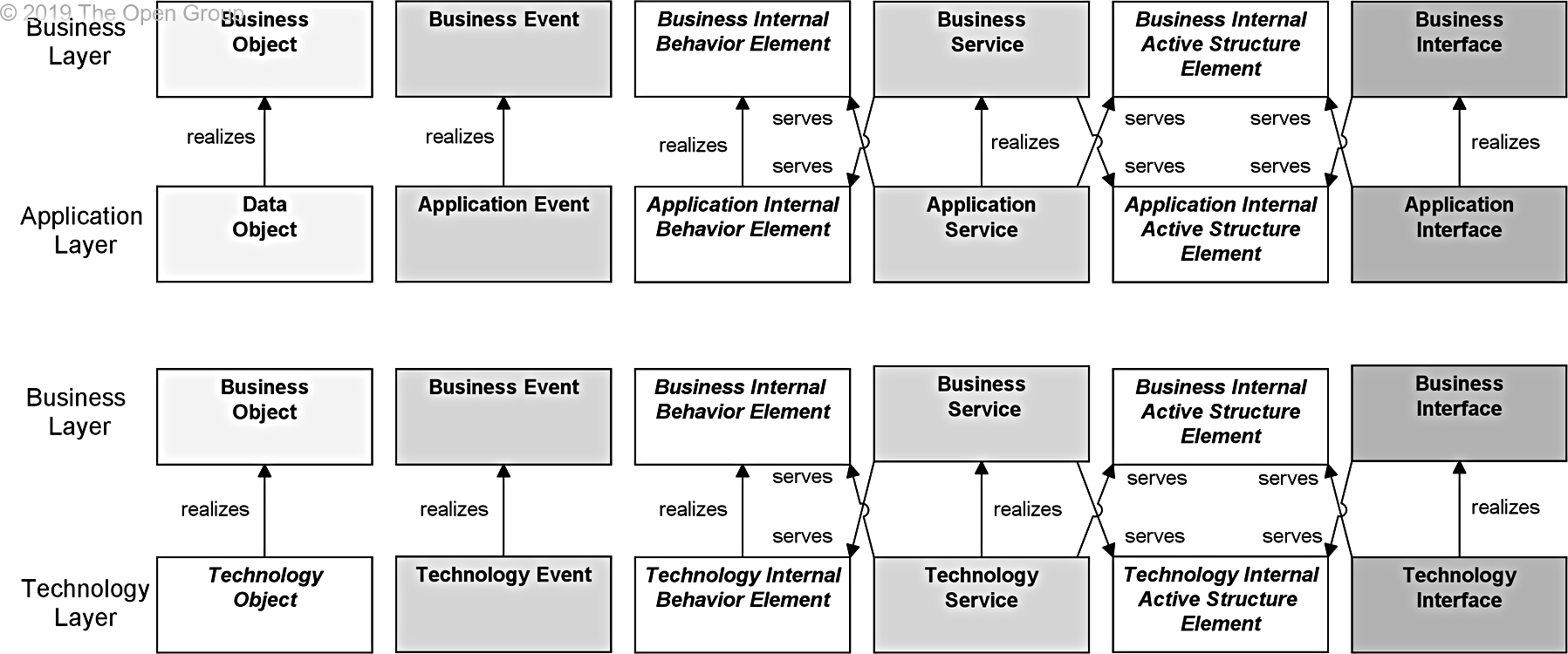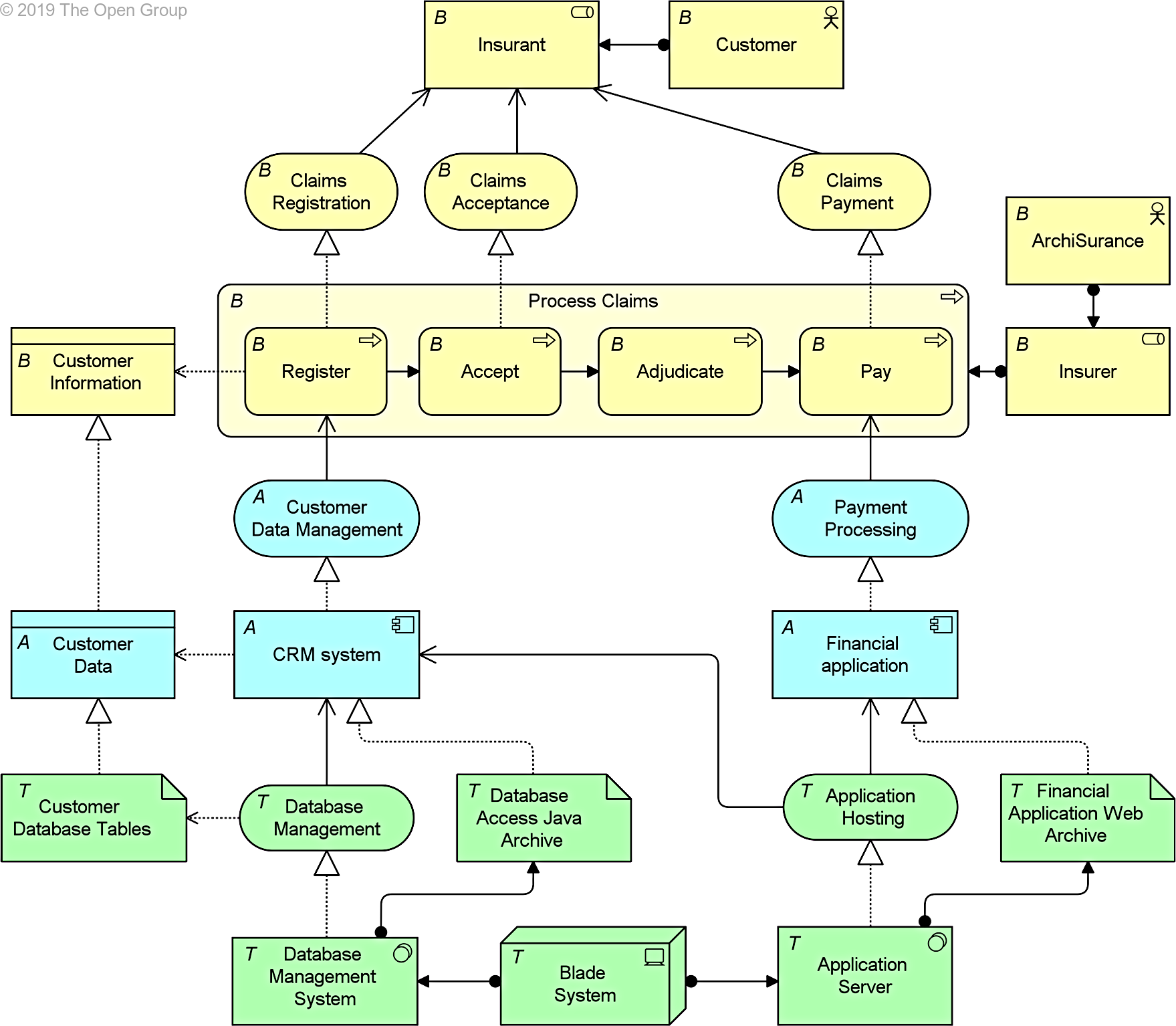Introduction
Enterprise Architecture (EA) is a critical discipline that helps organizations align their business strategies with their IT infrastructure. One of the key frameworks used in EA is ArchiMate, which provides a standardized way to describe, analyze, and visualize the relationships among business processes, organizational structures, information flows, IT systems, and technical infrastructure. This guide will delve into the core layers of enterprise architecture—the Business Layer, Application Layer, and Technology Layer—and explain their relationships using ArchiMate.
Core Layers of Enterprise Architecture
1. Business Layer
The Business Layer represents the business processes, functions, and services of an organization. It includes elements such as:
- Business Object: Represents a concept or thing relevant to the business.
- Business Event: Represents something that happens within the business.
- Business Internal Behavior Element: Includes business processes, functions, and interactions.
- Business Service: Represents a service provided by the business.
- Business Interface: Represents a point of access where a business service is made available to the environment.
2. Application Layer
The Application Layer represents the application services and components that support the business processes. It includes elements such as:
- Data Object: Represents a piece of data used or produced by an application.
- Application Event: Represents something that happens within an application.
- Application Internal Behavior Element: Includes application processes, functions, and interactions.
- Application Service: Represents a service provided by an application.
- Application Interface: Represents a point of access where an application service is made available to the environment.
3. Technology Layer
The Technology Layer represents the physical infrastructure that supports the application and business layers. It includes elements such as:
- Technology Object: Represents a physical object in the technology layer.
- Technology Event: Represents something that happens within the technology infrastructure.
- Technology Internal Behavior Element: Includes technology processes, functions, and interactions.
- Technology Service: Represents a service provided by the technology infrastructure.
- Technology Interface: Represents a point of access where a technology service is made available to the environment.
Relationships Between Layers
1. Alignment of the Business Layer and Lower Layers
The relationships between the Business Layer and the Application and Technology Layers are crucial for understanding how business processes are supported by IT infrastructure. The key relationships are:
-
Serving Relationships: These relationships indicate how application services support business behavior elements and how technology services support application behavior elements. For example, an application service may serve a business process, and a technology service may serve an application component.
-
Realization Relationships: These relationships indicate how elements in the lower layers realize elements in the higher layers. For example, a data object may realize a business object, and a technology object may realize a data object.
2. Alignment of the Application and Technology Layers
The relationships between the Application Layer and the Technology Layer are essential for understanding how applications are supported by the underlying technology infrastructure. The key relationships are:
-
Serving Relationships: These relationships indicate how technology services support application behavior elements and how application services support technology behavior elements. For example, a technology service may serve an application process, and an application service may serve a technology component.
-
Realization Relationships: These relationships indicate how elements in the Technology Layer realize elements in the Application Layer. For example, a technology object may realize a data object, and a technology process may realize an application process.
Example Diagrams
Diagram 1: Relationships Between Business Layer and Application and Technology Layer Elements
This diagram illustrates the serving and realization relationships between the Business Layer and the Application and Technology Layers. It shows how business processes are supported by application services and how application services are supported by technology services.

Diagram 2: Relationships Between Application Layer and Technology Layer Elements
This diagram illustrates the serving and realization relationships between the Application Layer and the Technology Layer. It shows how application processes are supported by technology services and how technology services are supported by technology infrastructure.

Diagram 3: Integrated View of Cross-Layer Relationships
This diagram provides an integrated view of how the different layers of enterprise architecture are connected. It shows how business processes are supported by application services, which in turn are supported by technology services. This integrated view helps in understanding the overall alignment of business and IT strategies.

Conclusion
Understanding the relationships between the Business, Application, and Technology Layers is essential for effective enterprise architecture. ArchiMate provides a standardized way to model these relationships, helping organizations align their business strategies with their IT infrastructure. By using the serving and realization relationships, organizations can ensure that their business processes are supported by the right applications and technology infrastructure, leading to better business-IT alignment and improved operational efficiency.